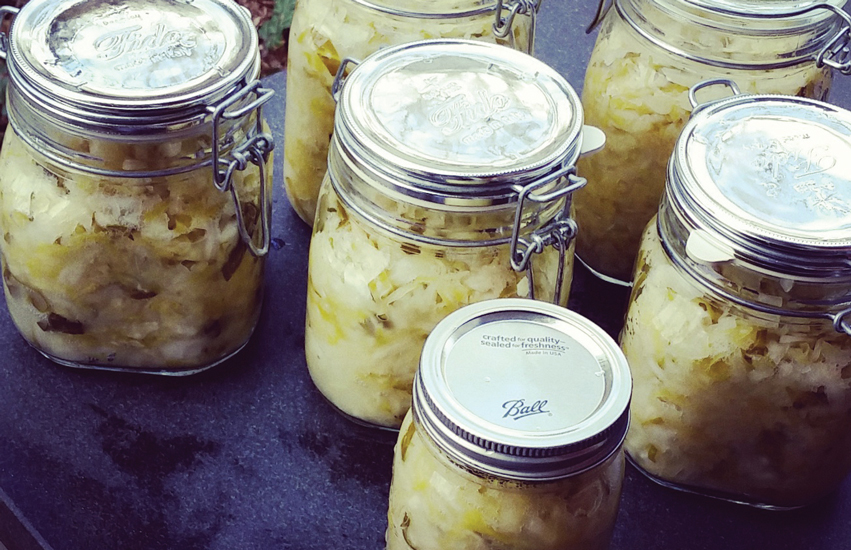Fermentation is an anaerobic process that converts sugars, such as glucose, into other compounds in order to produce energy. Since ancient times, humans have harnessed the process to produce food and drink. Lactic acid-forming bacteria are naturally present in almost all vegetables and fruits. When allowed to take their natural course, these bacteria cause catabolic changes in certain sugars, resulting in two new products: lactic acid and carbon dioxide. The lactic acid breaks down foods, making them easily digestible, while the carbon dioxide bubbles off. Homemade sauerkraut and other fermented foods—such as natural yogurts, kimchi and kombucha—contain live microorganisms called probiotics, which offer a range of health benefits.
Making sauerkraut at home is not only fun, it’s easy… so let’s get started!
 Step 1:Cabbage is Queen of the Crock! Here is my fermentation crock, which includes weights (also known as “secondary followers”) to keep the cabbage submerged under the brine. If you don’t have a crock, you can use a food-grade plastic bucket or mason jar. To start, wash your hands, fermentation vessel, knife and cutting board with soap and warm water. Don’t use antibacterial soaps as they may inhibit the fermentation process. Wash the cabbage in cool water.
Step 1:Cabbage is Queen of the Crock! Here is my fermentation crock, which includes weights (also known as “secondary followers”) to keep the cabbage submerged under the brine. If you don’t have a crock, you can use a food-grade plastic bucket or mason jar. To start, wash your hands, fermentation vessel, knife and cutting board with soap and warm water. Don’t use antibacterial soaps as they may inhibit the fermentation process. Wash the cabbage in cool water.
Step 2:Save a few whole cabbage leaves to help hold the tiny bits of shredded cabbage under the brine. These leaves are called “primary followers.” Set aside.
Step 3: Cut the washed cabbage into four wedges and remove the core from each piece. Slice into thin strips.
Step 4: For every three pounds of cabbage, add 1½ tablespoons of sea salt. Don’t use iodized salt. You can weigh the cabbage at the store or farmer’s market if you don’t have a scale at home.
Step 5: Remember to wash your hands before starting this step, and don’t use antimicrobial soap. Sprinkle the salt over the shredded cabbage. Use your hands to massage the cabbage. Keep massaging until it is limp and you see brine forming in the bottom of the bowl.

Step 6: The cabbage should look limp and wet, and will start to glisten. It is now ready to pack into a fermentation vessel. As you pack the crock or jar, firmly press down on the cabbage to remove any air pockets or bubbles. As you press down, you’ll see the brine increasing. Once the crock or jar is filled, press down firmly, and you should see the brine cover the cabbage. Make sure not to fill it completely—leave a few inches at the top. This is called headspace. You need room for the weight (secondary follower) to keep the kraut submerged in the brine.
Step 7: Place the cabbage leaves (primary follower) over the cabbage.
 Step 8: Place the secondary follower over the cabbage leaves and press down firmly to submerge the cabbage in the brine. (If you don’t have a crock with weights, you can use a plate and a Ziploc baggie filled with water.) Cover the crock with a dish towel and place in a cool spot, ideally between 55° and 75° F.
Step 8: Place the secondary follower over the cabbage leaves and press down firmly to submerge the cabbage in the brine. (If you don’t have a crock with weights, you can use a plate and a Ziploc baggie filled with water.) Cover the crock with a dish towel and place in a cool spot, ideally between 55° and 75° F.
Check your kraut every day to make sure it remains submerged. If it isn’t, press the kraut below the brine. You will see some scum on top—this is generally harmless. If you see mold, scoop it out.
A small batch of sauerkraut may take just a week to ferment, while a large batch may take a month. It is very important to keep everything below the brine. Submerge in brine and all will be fine!
Step 9: Taste your sauerkraut every few days. When it is done, it should taste pleasingly sour and “pickle-y.” It should not taste acidic or vinegary. Once it is complete, you may need to scoop off the top layer. Throw the first follower (the cabbage leaves) away. The remaining cabbage should be white or slightly yellow, yet crisp or al dente. Don’t eat the kraut if it looks slimy or smells rotten.
Step 10: If you plan to store your fermented vegetables for more than a month, it is best to use plastic or glass lids, rather than metal. Select glass jars with lids; wash them in hot, soapy water; and dry well. Pack the jars firmly with your hands. Push the sauerkraut below the brine for storage.
Step 11: Store the sauerkraut in sealed containers in the refrigerator. It should stay fresh-tasting and be crunchy for six to 12 months. Enjoy! a&s



